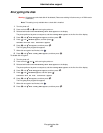
Notices
112
Notices
• Licensing notice
• Electronic emission notices
• The United Kingdom Telecommunications Act
1984
• Noise emission levels
• ENERGY STAR
• Waste from Electrical and Electronic
Equipment (WEEE) directive
• Laser notice
• Radio frequency statements
• European Community (EC) directives
conformity
• India emissions notice
• Statement of Limited Warranty for
Lexmark W840
Licensing notice
The printer resident software contains software developed and
copyrighted by Lexmark.
In addition, the printer resident software may contain:
• Lexmark modified software licensed under the provisions of
the GNU General Public License version 2 and/or the GNU
Lesser General Public License version 2.1
• Software licensed under the BSD license
• Software licensed under other licenses
Click the title of the document you want to review:
• BSD License and Warranty statements
• GNU General Public License
• Open Source License
The Lexmark modified third-party software covered by these third-
party licenses is free software; you can redistribute it and/or modify
it under the terms of the licenses referenced above. These licenses
do not provide you any rights to the Lexmark copyrighted software
in this printer.
Since the third-party licensed software the Lexmark modifications
are based on is supplied explicitly without warranty, use of the
Lexmark modified version is similarly provided without warranty.
See the warranty disclaimers in the referenced licenses for
additional details.
To obtain source code files for the Lexmark modified GNU licensed
software, launch the drivers CD that shipped with your printer and
click Contact Lexmark.
For source code that is required to be made available with the
product, see the publications CD in the en/OpenSource directory.
Electronic emission notices
Federal Communications Commission (FCC)
compliance information statement
The Lexmark W840, Machine Type 4024, has been tested and
found to comply with the limits for a Class A digital device, pursuant
to Part 15 of the FCC Rules. Operation is subject to the following
two conditions: (1) this device may not cause harmful interference,
and (2) this device must accept any interference received, including
interference that may cause undesired operation.
The FCC Class A limits are designed to provide reasonable
protection against harmful interference when the equipment is
operated in a commercial environment. This equipment generates,
uses, and can radiate radio frequency energy and, if not installed
and used in accordance with the instruction manual, may cause
harmful interference to radio communications. Operation of this
equipment in a residential area is likely to cause harmful


















